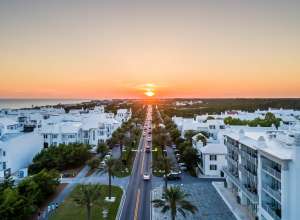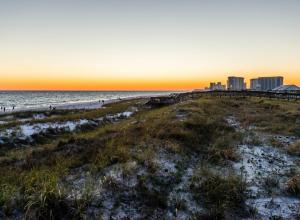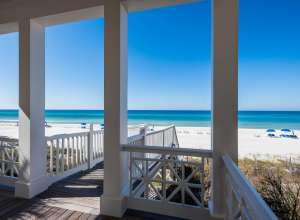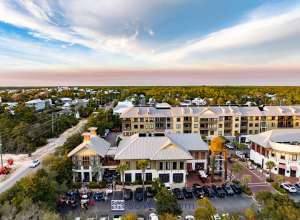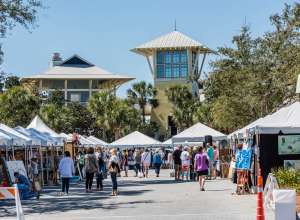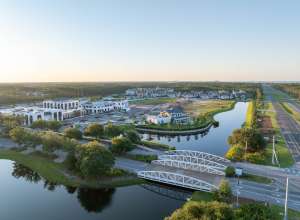About an hour northeast of SoWal, just off I-10 at Chipley, Florida, Falling Waters State Park features huge trees and fern-covered sinkholes that line Sink Hole Trail, the boardwalk that leads visitors to Florida's highest waterfall.
Falling Waters Sink is a 100-foot deep, 20-foot wide cylindrical pit into which flows a small stream that drops 73 feet to the bottom of the sink. The water's final destination remains unknown. Only a few miles south of I-10, the park provides travelers with a quiet, serene stop on their journey.
Visitors can see beautiful native and migrating butterflies in the butterfly garden, take a dip in the lake, or have a family picnic. Hikers can experience the verdant, gently sloping landscape of North Florida. Park rangers host interpretive programs in the amphitheater. Full-facility campsites nestled in a shady pine forest provide the perfect excuse for an overnight stay at Falling Waters.
During the 1778 British occupation of Florida, Native Americans lived on Falling Waters Hill and the surrounding area. No written records remain but artifacts are often found after a field is tilled. Two industries operated near the waterfall -- a gristmill powered by the waterfall ground corn into grits and cornmeal during the Civil War period, and in 1891, a legal whiskey distillery furnished spirits to an area wine shop set up for railway construction workers. In 1919, one of Florida’s first oil wells was drilled at Falling Waters. Indian legends and a wildcat stock promoter’s claim of oil helped get the project going, but the drillers had little luck. When a depth of 3,900 feet was reached, a blow of gas gave area residents a false sense of hope. Promoters continued to drill to a final depth of 4,912 feet but with no commercial quantity ever found, the well was capped in 1921.
From a Spanish diary written 400 years earlier, speculators believed there was oil in what is now Falling Waters State Park. They started a drilling operation in 1919 using a wooden derrick and a steam-driven engine. After drilling nearly 5,000 feet, no oil was found in any commercial quantity. The well was capped in 1921 and all that remains is the sludge pit for the well and a stately magnolia tree that marks the site.
Florida is special in many ways. One is that many of Florida's ecosystems are fire dependant. Falling Waters State Park has the special distinction as the first park to perform a prescribed burn. The butterfly milkweed in this photo is growing as a result of a burn that took place only two months before the picture was taken. Without fire, this plant species and many others would lay dormant or disappear altogether. Prescribed burning allows the ecosystems to thrive while helping to prevent more destructive wildfires.
The campground has a campfire circle and amphitheater for camper gatherings and summer interpretive programs presented by one of the Ranger staff. Spend the evening with a Park Ranger and watch a slide show at the amphitheater, or sit around a campfire and take in an interpretive talk and experience why the real Florida is so special. These programs are given on Saturday evenings and are free to registered campers.
Campers can spend the night on one of the highest hills in Florida. Situated in a pine forest 324 feet above sea level, it is one of the nicest campgrounds anywhere. Twenty-four campsites equipped with water, electricity, picnic tables, ground grills and a clothesline are available. There is a dump station for your convenience. Pets are welcome but must remain under the control of the owner at all times. Fireside chats with a park ranger are offered seasonally on Saturdays.
The park has three short nature trails. One trail will take you past the butterfly garden as you stroll toward the waterfall sinkhole. Once there, you can actually walk down into this sinkhole and get a breath taking view of Florida's highest waterfall. Then take an elevated boardwalk around a series of sinkholes under a canopy of southern magnolias and other hardwoods. There are self-guided tours and information kiosks throughout the park. A guided tour by a Park Ranger of Falling Waters State Park is available to groups by prior notification (call the park). As always, if your curiosity has gotten the best of you, and you want to know why we burn the park, have sink holes, or even have parks at all, just ask a Park Ranger.
The park has a two-acre lake with a white sand beach. It is a great place to relax and get your feet wet. The swimming area of the lake is sectioned off for safety, and has a sand bottom. There are picnic tables, benches, and restrooms under shade trees. You can fish at the lake in designated areas with a Florida Freshwater Fishing License.

